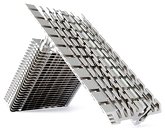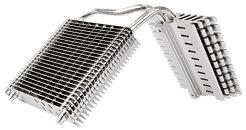Wednesday, February 24th 2010
Thermalright Unveils VRM-R5 Heatsink for Radeon HD 5800 Series Graphics Cards
A couple of months after releasing the VRM-R3 and VRM-R4 VRM heatsinks for the ATI Radeon HD 5800 series graphics cards, Thermalright is back with yet another HD 5800 series VRM heatsink, the VRM-R5. The new heatsink offers passive or fan-assisted cooling dedicated the the graphics card's VRM chips - major heat-producing components next to the GPU and memory chips. Cooler VRM chips could mean better electrical stability, affecting overclocking headroom.
The VRM-R5 makes the main block portion of the heatsink elaborate, with complex, branched metal ridges. From here two 6 mm aluminum heat pipes conduct heat to a block of aluminum fins. The fins are punched to improve heat dissipation. An 80 mm fan can be attached to this block for active cooling. The heatsink measures 118 x 117 x 122 mm, and weighs 140 g. The heatsink is compatible with some VGA coolers by Thermalright, notably Spitfire. It will reach stores next week at a price of 23 EUR.
Source:
TechConnect Magazine
The VRM-R5 makes the main block portion of the heatsink elaborate, with complex, branched metal ridges. From here two 6 mm aluminum heat pipes conduct heat to a block of aluminum fins. The fins are punched to improve heat dissipation. An 80 mm fan can be attached to this block for active cooling. The heatsink measures 118 x 117 x 122 mm, and weighs 140 g. The heatsink is compatible with some VGA coolers by Thermalright, notably Spitfire. It will reach stores next week at a price of 23 EUR.



8 Comments on Thermalright Unveils VRM-R5 Heatsink for Radeon HD 5800 Series Graphics Cards
The fin array bends round the card and stands vertically so if you have a side-panel fan it will be cooled by that.
Shame these things are so expensive though, wish thermalright made a budget version it would still be better then the shite stuff that comes with GPU coolers.
Not to mention taking up way too much space.
Single heatpipe with copper base bent in a way that actually places it at the end of the GPU ( far enough away so you can still plug in your power-cables on rear facing power connections )
Since most cases have front intake these days it would work great.
It would also cost about 5 pounds vs the 25 of thermal-rights coolers.
It may take room but it does cool those hot vrm's.